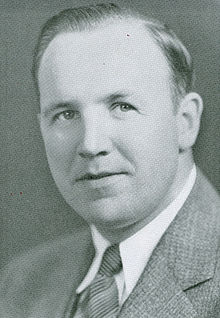Murray Van Wagoner
| Murray Van Wagoner | |
|---|---|
 |
|
| 38th Governor of Michigan | |
|
In office January 1, 1941 – January 1, 1943 |
|
| Lieutenant | Frank Murphy |
| Preceded by | Luren Dickinson |
| Succeeded by | Harry Kelly |
| Personal details | |
| Born | March 18, 1898 Kingston, Michigan |
| Died | June 12, 1986 (aged 88) Farmington Hills, Michigan |
| Political party | Democratic |
| Spouse(s) | Helen Jossman |
| Alma mater | University of Michigan |
| Religion | Episcopalian |
Murray Delos Van Wagoner (March 18, 1898 – June 12, 1986) was an American politician. He served as the 38th Governor of Michigan from 1941 to 1943.
Van Wagoner was born near Kingston, Michigan in Tuscola County. In 1921, he received a civil engineering degree from the University of Michigan. He worked for a firm in the private sector, and became the owner of his own company. He married Helen Jossman and they had two children together. In 1930, he served as Oakland County drain commissioner until 1933 when he became Michigan State Highway commissioner, a position he held until he was elected governor in 1940.
Van Wagoner was a delegate to the Democratic National Conventions in 1936 and 1940, both of which re-nominated Franklin D. Roosevelt for U.S. President.
On November 5, 1940, he defeated the incumbent Republican Governor of Michigan, Luren Dickinson, by 131,281 votes to become Michigan's 38th governor. During his two years in office, he encouraged the construction of road projects and most famously the Mackinac Bridge, the elimination of a 27 million dollar deficit occurred, the state mental hospital was reinstated, a consolidated tax collection department was established, worker strikes involving the auto and electrical industries were dealt with, the reorganization of the Michigan civil service system was initialized, and measures were secured for the war effort.
In 1942, Van Wagoner was unsuccessful for re-election against Republican Harry Kelly. Van Wagoner was a delegate to the Democratic National Convention in 1944, which re-nominated President Roosevelt for his fourth term. In 1946, he ran for governor again and was defeated by Republican Kim Sigler. He was also a delegate to the 1952 convention, which nominated Adlai Stevenson, who was unsuccessful in the general election against Dwight D. Eisenhower.
...
Wikipedia
